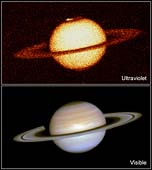|
COMETS EARTH JUPITER KUIPER BELT MARS MERCURY METEORITES NEPTUNE OORT CLOUD PLUTO SATURN SOLAR SYSTEM SPACE SUN URANUS VENUS ORDER PRINTS
PHOTO CATEGORIES SCIENCEVIEWS AMERICAN INDIAN AMPHIBIANS BIRDS BUGS FINE ART FOSSILS THE ISLANDS HISTORICAL PHOTOS MAMMALS OTHER PARKS PLANTS RELIGIOUS REPTILES SCIENCEVIEWS PRINTS
|
Related Document
Download Options
(Top) - This is the first image ever taken of bright aurorae at Saturn's northern and southern poles, as seen in far ultraviolet light by the Wide Field and Planetary Camera 2 aboard NASA's Hubble Space Telescope. Hubble resolves a luminous, circular band centered on the north pole, where an enormous auroral curtain rises as far as 1,200 miles (2,000 kilometers) above the cloudtops. This curtain changed rapidly in brightness and extent over the two hour period of our HST observations, though the brightest emissions remained at a position fixed in sun angle, near "dawn" in the north auroral band. The image was taken on October 9, 1994, when Saturn was at a distance of 831 million miles (1.3 billion kilometers) from Earth. The aurora is produced as trapped charged particles precipitating from the magnetosphere collide with atmospheric gases -- molecular and atomic hydrogen in Saturn's case. As a result of the bombardment, Saturn's gases glow at far-ultraviolet wavelengths (110-160 nanometers) which are absorbed by the Earth's atmosphere, and so can only be observed from space-based telescopes. Saturn's magnetic field is nearly perfectly aligned with the planet's rotation, giving the auroral "ring" its symmetry centered on the pole. (The southern aurora is faintly visible in this view despite the fact that Saturn's northern pole is now tilted slightly toward Earth.) The Hubble images demonstrate our capability to record from the Earth the auroral brightness and distribution about Saturn's poles, which will ultimately complement the in situ measurements of Saturn's magnetic field and charged particles to be made by the NASA/ESA Cassini spacecraft near the turn of the century. Study of the aurora on Saturn had its beginnings a few decades ago. The Pioneer 11 probe observed a far-ultraviolet brightening on Saturn's poles in 1979. Beginning in 1980, a series of spectroscopic observations by the International Ultraviolet Explorer (IUE) have sporadically detected emissions from Saturn's auroral zones. The Saturn flybys of the Voyager 1 and 2 spacecraft, in the early 1980s, found auroral emissions confined to a circumpolar ring. (Bottom) - For comparison, this is a visible-light color composite image of Saturn as seen by Hubble on December 1, 1994. Unlike the ultraviolet image, Saturn's familiar atmospheric belts and zones are clearly seen. The lower cloud deck is not visible at UV wavelengths because sunlight is reflected from higher in the atmosphere. Credits: J.T. Trauger (JPL), J.T. Clarke (Univ. of Michigan), the WFPC2 science team, and NASA |
